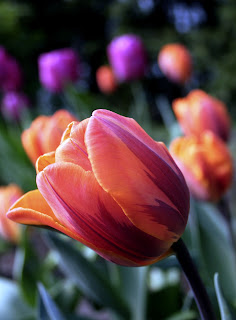For the past two years, I have run a garden goalroll: this is my place to scribble horticultural marginalia and to post reminders about what needs doing when. Or to record what I still haven't done. Bearded irises, I hear you. I'm making plans for a glorious 2011!
Dead of winter
Read up on xeriscaping in anticipation of extending the bed in front of the day lilies. The drought-killed lawn there is going to go! Plants to consider:
- Coneflower "Green Jewel" (move from current location)
- Sedum "Autmn Joy" (move from behind compost bin)
- Fort Ticonderoga bearded irises (move from current location)
- Pink coneflower
Order dahlia tubers. Ordered 3/1/2011
- Back of house: Arabian Nights, Rae Ann's Peach, Rose Toscano, Patty Cake
- Old side bed: Karras 150, Bonne Esperance
- New side bed: Park Princess
When the forsythia blooms
Continue to prune front foundation plantings into shape.
Prune clethra to remove deadwood and shape.
Edge garden beds.
After the forsythia blooms
Dig out a new curved bed in front of the day lilies, amend, and load up with drought-tolerant plants.
Lightly fertilize bearded irises with bonr meal, superphosphate or other low nitrogen (5-10-15) supplement.
Lightly fertilize bearded irises with bonr meal, superphosphate or other low nitrogen (5-10-15) supplement.
May or June
After flowering, shear Amsonia hubrichtii by 1/3 of its height to promote better form.
When it is 3 feet tall, cut the joe pye weed "Gateway" back to half its height to encourage dense growth.
Pinch sedum "Autumn Joy" when it reaches 8 inches; stake with ring.
Organize the bearded irises, so that visually compatible cultivars are grouped together. Tag individual plants so that they can be moved later in the season.
Stake dahlias when the tubers are planted and again and again as they grow. Stop dahlias by pinching stem back to four pairs of leaves.
Pinch back shasta daisies to 6" in late May.
And stake, stake, stake!
Columbus Day
Veterans Day
Thanksgiving

Dig in bone meal around peonies.
Lightly feed evergreen along front of house with Holly-Tone.
Veterans Day
While daytime temperatures are still above 40 degrees, spray an anti-transpirant, like Wilt-Pruf or Wilt Stop, on "Sky Needle" hollies to prevent winter kill.
Top-dress beds with composted cow manure.
Thanksgiving
Winter-sow larkspur seeds.



















































